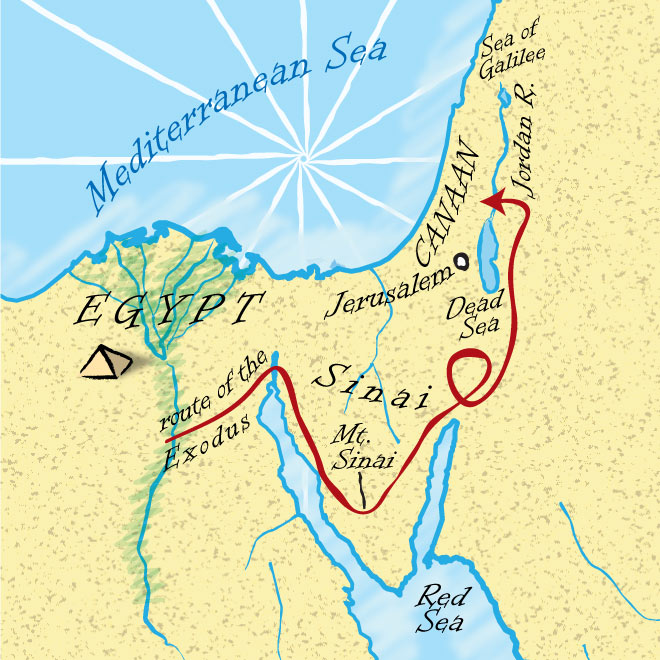|
Mount Sinai, also known as Moses Mountain, is recorded in the Bible as the place where Moses received the Ten Commandments. “When Moses came down from Mount Sinai with the two tablets of the covenant law in his hands, he was not aware that his face was radiant because he had spoken with the Lord.” (Exodus 34:29, NIV) In today’s world, there is a Mount Sinai in the Sinai Peninsula of Egypt, which many consider being the location of the Biblical Mount Sinai. Unfortunately, it has not been possible to prove this.
The Sinai Peninsula is located in Egypt between the Mediterranean and Red Sea. With an area of 23,000 square miles and a population of 6000, people, the peninsula makes up 6% of Egypt’s total landmass. Mount Sinai has an elevation of 2,285 m (7,497 ft), however, it is not the highest mountain in the region. Its neighbouring mountain, Mount Catherine, is the highest peak in Egypt at 2,629 m (8,625 ft). The history of the name Sinai is a little obscure. Some people believe the mountain only earned that name because it was believed to be the Biblical mountain. Others suggest it may have derived from an ancient Mesopotamian moon-god called Sīn. Moses is a prophet in Judaism, Christianity and Islam; therefore, the mountain is sacred for thousands of people. Jewish tradition claims that not only did God reveal the Decalogue, but He also revealed the entire corpus of biblical text and interpretation to Moses on Mount Sinai. During the 6thcentury AD, a monastery was constructed by order of the Emperor Justinian at the foot of Mount Sinai. Officially called the Sacred Monastery of the God-Trodden Mount Sinai, it is also known as Saint Catherine’s Monastery, named after Catherine of Alexandria – Saint Catherine of the Wheel. It is the oldest working Christian monastery in the world, inhabited by a few monks of the autonomous Orthodox Church. It contains a library of ancient biblical manuscripts, some of which have helped scholars reconstruct the text of the Bible. This includes the Codex Sinaiticus, the earliest known manuscript of the Christian Bible dating from the 4thcentury AD; however, this book now resides in the British Museum. Mount Sinai first appears in the Bible in Exodus 19. “On the first day of the third month after the Israelites left Egypt—on that very day—they came to the Desert of Sinai. After they set out from Rephidim, they entered the Desert of Sinai, and Israel camped there in the desert in front of the mountain. Then Moses went up to God, and the Lord called to him from the mountain and said, “This is what you are to say to the descendants of Jacob and what you are to tell the people of Israel …” (verses 1-3, NIV) God created a covenant with Moses; if the people of Israel fully obey Him, God promises they will be his most treasured nation. The mountain is given its name, Mount Sinai, in verse 11 and is mentioned a further three times in the chapter. In chapter 24, Moses stayed on the top of Mount Sinai for forty days and forty nights whilst God gave him His written and verbal laws. These laws are written in greater detail in the book of Leviticus. God gave instructions for burnt offerings (Leviticus 7), the Sabbath (Lev. 25), punishment for disobedience (Lev. 26) and tithing (Lev. 27) amongst other things. In the New Testament, Stephen tells the Sanhedrin of Moses’ encounter with God on Mount Sinai. Numbers 3 provides an account of the family of Aaron and Moses at the time that God spoke to Moses on Mount Sinai. The tribe of Levi was presented to Aaron to assist him. In Numbers 28, God commands the Israelites to present to Him daily food offerings, which include two lambs, grain and oil. “This is the regular burnt offering instituted at Mount Sinai as a pleasing aroma, a food offering presented to the Lord.” (Numbers 28:6, NIV) In Nehemiah 9, the Israelites remembered the laws and regulations that God gave them on Mount Sinai. Repenting of their sins, they fasted, wore sackcloth and put dust on their heads. There is only one reference to Mount Sinai in the Bible that is not connected to Moses. In Galatians 4, Paul expresses his concern for the Galatians. He uses the wife and concubine of the prophet Abraham as an analogy for their current predicament. “These things are being taken figuratively: The women represent two covenants. One covenant is from Mount Sinai and bears children who are to be slaves: This is Hagar. Now Hagar stands for Mount Sinai in Arabia and corresponds to the present city of Jerusalem, because she is in slavery with her children. But the Jerusalem that is above is free, and she is our mother.” (Galatians 4:24-26, NIV) Being the location of the origin of the Ten Commandments makes Mount Sinai one of the most important in the Bible. It is a shame that the true location cannot be agreed upon. Different scholars contest the route the Israelites took; therefore, any number of mountains could be the true location. Suggested mountains include:
0 Comments
Your comment will be posted after it is approved.
Leave a Reply. |
©Copyright
We are happy for you to use any material found here, however, please acknowledge the source: www.gantshillurc.co.uk AuthorRev'd Martin Wheadon Archives
June 2024
Categories
All
|

 RSS Feed
RSS Feed